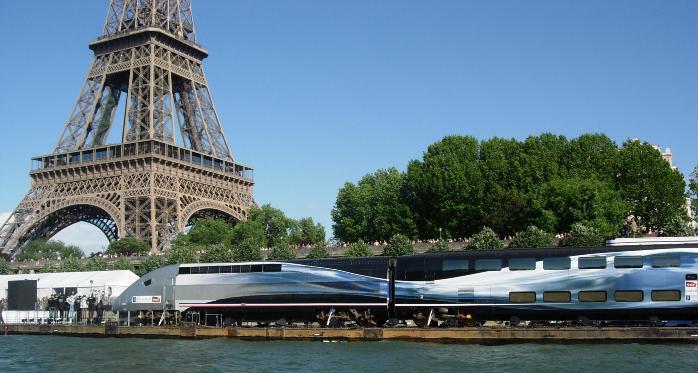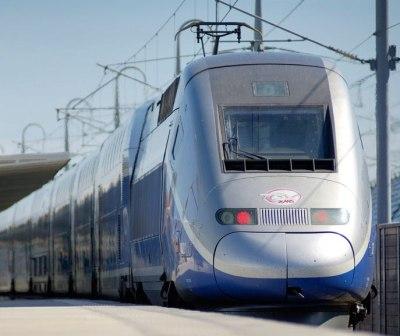|
Copyright ©2010 by Paul Niquette. All rights reserved. |
||||||||||||||||||||||||||||||||||||||||||||||||||
 On
April 3, 2007, headlines all over the world heralded the
World's Fastest Train, the
V150,
a special consist
built by a partnership between Alstom
Réseau Ferré de France and Société Nationale
des Chemins de fer Français. The V150 set a new
world record of 574.8 kph (357.0 mph) on an isolated
section of trackway between Strasbourg and Paris, as
recorded in this video.
The
photograph below shows the V150 exhibited aboard a barge
on La Seine... On
April 3, 2007, headlines all over the world heralded the
World's Fastest Train, the
V150,
a special consist
built by a partnership between Alstom
Réseau Ferré de France and Société Nationale
des Chemins de fer Français. The V150 set a new
world record of 574.8 kph (357.0 mph) on an isolated
section of trackway between Strasbourg and Paris, as
recorded in this video.
The
photograph below shows the V150 exhibited aboard a barge
on La Seine...
...with some nearby tower in the background. "V150" was the code name signifying its targeted speed of 150 m/s. That achievement was marked about two minutes into the video, and the train continued to accelerate, reaching a peak of 159.7 m/s (~175 yards per second). Think of a couple of football fields passing your train window at your resting heart-rate..
The World's Fastest Train draws 19.6 megawatts of electrical power and develops a total of 26,300 horsepower. Special attributes of the V150 include [1] synchronous, permanent-magnet traction motors; [2] actively controlled pantograph; [3] enlarged wheel diameter by 19% to limit the rotational speed of the powertrain (5,688 vs 8,533 rpm); and [4] aerodynamic improvements -- [a] air dam, [b] flush-mounted windshield, [c] rigid membranes filling the space between cars, [d] roof fairings over the forward pantograph opening -- all resulting in a 15% savings in drag.
Whereas pictures of high-speed trains invariably feature their streamlined designs from the front, it is the rear of a body moving through a fluid that determines aerodynamic drag more than the front, with the familiar tear-drop shape being most ideal. Passenger trains must travel in either direction, so their shapes are necessarily symmetrical. Those red lights in the picture on the right indicate that our view is from the rear of the V150, with 'clam-shells' closed over its unused coupler. We also see the pantograph on the rear car, which captures the electric power for distribution to traction motors throughout the train. The V150's record-setting runs were conducted on a customized test-track [a] 88 miles long at a location chosen for favorable vertical profile, [b] long-radius curves with [c] superelevation set higher than standard, [d] catenary voltages increased 24% to 31 kVac (over standard 25 kVac), and [e] messenger wire tension pulled tighter than normal by 60% for mechanical stability.
What would be your estimated overall speed for the same trip, making stops as indicated in the table below?  |

